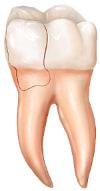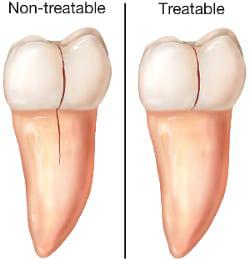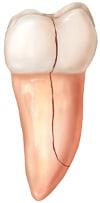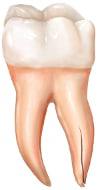CRACKED TEETH
Cracked teeth can manifest various symptoms, such as pain during chewing, sensitivity to temperature, or discomfort upon releasing biting pressure. Additionally, the pain may be intermittent, posing challenges in diagnosing the underlying cause of discomfort.
Chewing can cause movement of the cracked tooth fragments, leading to irritation of the pulp within. Additionally, when the biting pressure is released, the crack may close rapidly, resulting in sharp pain. Over time, the damaged pulp can cause persistent toothache, even without any chewing. It is important to note that cracks have the potential to cause infection in the pulp tissue, which can then spread to the surrounding bone and gum.
There are a few differing types of cracked teeth, each with its own unique characteristics and symptoms.

 Fractured Cusp: This type of crack often occurs around a dental filling. It usually does not affect the pulp of the tooth and, as a result, does not cause much pain.
Fractured Cusp: This type of crack often occurs around a dental filling. It usually does not affect the pulp of the tooth and, as a result, does not cause much pain. Cracked Tooth: This type of crack extends from the chewing surface down towards the root. Early diagnosis is crucial to save the tooth.
Cracked Tooth: This type of crack extends from the chewing surface down towards the root. Early diagnosis is crucial to save the tooth. Split Tooth: This type of crack is often the result of an untreated cracked tooth. The crack has progressed further into the tooth, resulting in the tooth being segmented into two parts.
Split Tooth: This type of crack is often the result of an untreated cracked tooth. The crack has progressed further into the tooth, resulting in the tooth being segmented into two parts. Vertical Root Fracture: These cracks begin in the root of the tooth and extend towards the chewing surface. They show minimal symptoms and may go unnoticed till the surrounding bone and gum become infected.
Vertical Root Fracture: These cracks begin in the root of the tooth and extend towards the chewing surface. They show minimal symptoms and may go unnoticed till the surrounding bone and gum become infected.